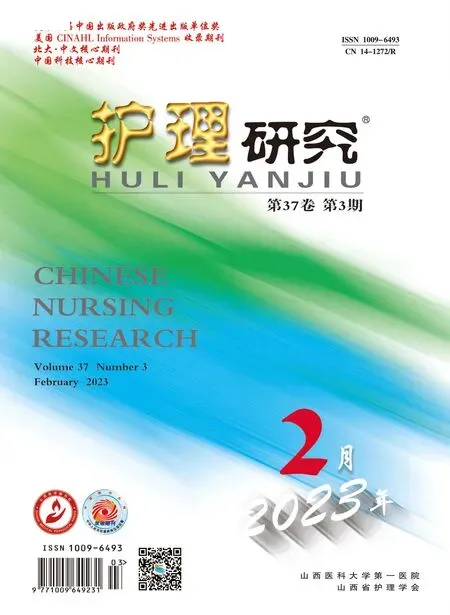帕金森病病人居家康复运动影响因素及干预研究进展
王巧红,张晓晴,郭静,魏吉林,杨辉*
·科研综述·
帕金森病病人居家康复运动影响因素及干预研究进展
王巧红1,2,张晓晴1,郭静2,魏吉林2,杨辉1,2*
1.山西医科大学护理学院,山西 030001;2.山西医科大学第一医院
总结帕金森病病人居家康复运动影响因素和干预策略的研究现状,为我国临床医护人员制定帕金森病病人居家康复运动干预方案提供依据。
帕金森病;居家康复;康复运动;影响因素;干预;护理;综述
帕金森病(Parkinson's disease,PD)是仅次于阿尔茨海默病的常见神经退行性疾病,与多巴胺能神经元的退行性变和随之而来的神经递质多巴胺的减少有关,导致运动和非运动的改变及病人日常生活能力和生活质量的逐渐下降[1⁃2]。目前,尚无有效的药物和技术可以停止或逆转该病进展[3⁃4]。帕金森病病人受益于持续不断的运动,以改善和维持身体功能[5⁃6],更好地管理疾病。但临床实践中仍然有许多病人久坐不动,导致合并症增加,给家庭和社会造成沉重的照顾负担和经济负担[7⁃8]。我国90%的帕金森病病人选择居家康复,居家康复是医院康复的有效替代方案。因此,建立基于社区和家庭的帕金森病病人康复运动长效模式,保持病人长期坚持康复运动的动力[9]是医护人员面对的挑战。
1 居家康复运动概述
1.1相关定义运动与体力活动不同。体力活动是指任何导致人体骨骼肌收缩所产生的能量消耗的身体运动,如种花、扫地和散步等日常活动都包括在体力活动范围内[10]。运动也称锻炼,被定义为身体活动的一个子类别,包括有计划、有组织、重复、有目的、旨在改善身体健康的一个或多个组成部分的体育活动[8]。居家康复运动在本研究中是指在非医疗机构场所,非专业医护人员陪伴下,病人在家庭和社区进行的运动或锻炼,以期改善疾病症状,延缓疾病进展,改善疾病结局。
1.2康复运动的重要性帕金森病发病机制复杂,现有研究显示,可能是由于环境因素、年龄、老化、细胞凋亡、免疫异常、线粒体功能障碍和氧化应激过度等诸多因素影响,导致中脑黑质纹状体多巴胺能神经元变性、坏死,最终引起脑内纹状体多巴胺神经递质减少而发病[11⁃12]。运动可能起到神经保护作用,在动物模型上的运动实验显示,运动能够增加多巴胺的释放,通过下调多巴胺转运体的表达,增加细胞外的多巴胺,减少纹状体的多巴胺丢失,保存部分中脑多巴胺能神经元及修复多巴胺终端[13⁃14],对帕金森病潜在的病理产生直接影响,从而减缓疾病的进展。运动还与大脑中的许多结构、血管和神经分子变化有关,这些变化有助于改善老化大脑的身体、认知和行为功能[15]。尽管运动对帕金森病病人益处的机制尚缺乏完整了解,但迅速积累的证据显示锻炼的帕金森病病人有更好的结局[16⁃17]。多种类型的康复训练能够改善早中期帕金森病病人肌力、步态、运动功能和平衡功能,降低跌倒风险等[18⁃19];不同类型和强度的运动还可以有效改善帕金森病病人睡眠障碍、抑郁和认知功能等非运动症状[20],运动能在一定程度上减少帕金森病病人对药物依赖性的作用和药物使用剂量[21]。
1.3帕金森病病人康复运动现状帕金森病病人康复运动总体水平较低,即使是帕金森病Hoehn⁃Yahr 1期的病人活动水平也非常低[22],只有30%的人每天步行30 min,远远低于指南推荐水平[23]。而我国大部分帕金森病病人没有进行系统的康复训练[24],应在疾病所有阶段进行一系列的治疗性运动,以保持长期的运动依从性[9,25⁃28]。
2 帕金森病病人居家康复运动的影响因素
国内李伟等[29]研究指出,相比同年龄组的健康人,帕金森病病人运动能力下降约1/3,其中24%的能力下降与疾病进展、步行障碍和日常活动能力受限相关。精神障碍(如抑郁、孤独和痴呆)、疲劳等个体因素以及由于跌倒恐惧而导致的户外活动减少等多种因素,都会引起帕金森病病人活动能力降低。解璇等[30]研究指出,居家帕金森病病人康复锻炼总依从率处于中等偏低水平,病情分期、康复锻炼知识了解程度、是否身体疲劳、是否害怕跌倒、运动自我效能及社会支持是居家帕金森病病人康复锻炼依从性的主要影响因素。陈志等[31]指出,环境影响帕金森症病人的康复,主要涉及医院、社会、家庭3个方面,如药品和辅助器械等医疗设备以及与帕金森症病人康复息息相关的服务及政策。吴晓[32]通过实施包括康复目标、鼓励病人、增强社会支持、满足病人需求和利益等康复措施,提高帕金森病病人康复运动自我效能感,从而改善干预组病人的心理状态,促进病人功能康复。徐萍[33]也指出,自我效能与教育干预对帕金森病病人运动效能和平衡功能有显著作用。李昊[34]研究显示,医护人员和家庭共同参与及督促对于维持帕金森病病人康复运动具有重要作用。
国外研究指出,帕金森病病人运动的障碍因素包括结果期望低、缺乏时间、害怕摔倒、自我效能低以及缺乏卫生保健专业人员和组织的支持[9,35⁃36]。Khalil等[37]通过对帕金森病病人和康复治疗师进行质性访谈,提出帕金森病病人运动的障碍因素和促进因素,障碍因素包括缺乏疾病感知和参与运动的信息、疾病诊断困难、缺乏对物理治疗的转介、疾病特定问题(僵硬和疲劳)、环境(中心锻炼和家庭锻炼、个人锻炼和团体锻炼)及缺乏自我效能;促进因素是启动和维持锻炼计划的动机,包括结果预期和家庭支持。Afshari等[38]研究指出,得病前高运动量的病人在确诊后更有可能开始锻炼,而低运动量的人更有可能减少运动量,运动量少的人需要更多的激励因素,低运动量的人更常见的障碍是缺乏激励、疲劳和抑郁。除此之外,Schootemeijer等[39]综述了帕金森病病人运动的障碍和动力因素,指出一般健康障碍(与帕金森病无关)、害怕跌倒、锻炼伙伴及病友影响、锻炼地点交通不便、恶劣天气、文化挑战、锻炼的经济负担、拥挤的环境也是造成锻炼依从性差的因素;运动改善症状、运动纳入日常生活、相信体育运动对健康有益、希望保持独立性、与能力和兴趣相匹配的个性划运动方案、个人目标、高教育水平、家人或朋友的社会支持、专业支持、健康教育、社交活动、病友鼓励、掌握经验、绩效反馈与奖励是康复运动的促进因素。
3 帕金森病病人居家康复运动干预研究现状
3.1居家康复运动干预内容《欧洲帕金森病物理治疗指南》以国际功能、残疾和健康分类(International Classification of Functioning,Disability and Health,ICF)为指导框架,确定帕金森病5个核心功能障碍,即体能、转移、手活动、平衡和步态[40]。帕金森病病人的康复运动干预围绕改善核心功能障碍展开。于洋[41]研究指出,帕金森病的康复干预是多学科全程管理中非常重要的部分,应“贯穿于始终”,疾病不同时期侧重点有所不同,治疗方法设计应基于日常生活活动内容,治疗量应遵循“循序渐进”的原则。
国内孙文玉[42]在常规康复运动治疗方案的基础上加入导引术,包括八段锦的前两式和《养性延命录》[43]记载的五禽戏中的鹿戏、鸟戏和熊戏,结果显示提高了病人运动能力和生活质量。吴梦颖等[44]设计了互联网模式下帕金森病病人延续性康复应用软件,其“运动疗法”板块主要是通过视频指导病人进行肌肉放松训练、步态训练、关节活动度训练、缓慢下蹲式训练和低负荷运动训练等。刘燕平等[45]探讨了基于移动互联网的帕金森病病人家庭康复训练效果,康复训练内容包括步行、姿势、站起、平衡、床上移动、柔韧性等项目,每次30 min,每周4次,持续8周,结果显示改善了帕金森病病人的运动功能和日常生活能力。杨新萍等[46]探讨了家庭护理干预对帕金森病病人康复护理的效果,指出病人尽量多参与各种形式的活动,如散步、打太极拳、保健操等。陈东霞[47]应用长期家庭治疗中的缓慢下蹲式康复训练,结果显示提高了帕金森病病人的下肢运动水平和关节运动水平,缩短了临床症状改善时间,改善了病人生活质量评分,提高了训练效果。
研究显示,八段锦形式的气功练习比其他形式的训练计划更具优势,因为其在家庭物理干预的理想特征(成本效益高、简单、自我控制、安全、强度和持续时间低,不需要额外设备或大空间)和潜在的有益效果之间取得了积极的平衡[48⁃52]。八段锦已被证明可以改善帕金森病病人的非运动和运动相关的症状及其相关的功能结果[50,53⁃54]。Isernia等[55]探索了步行训练结合呼吸肌训练对帕金森病病人肺功能、呼吸肌力和功能运动能力的影响,结果表明步行训练可提高帕金森病病人的呼气肌训练效果。Van Der Kolk等[56]研究表明,以自行车为基础的高强度运动家庭锻炼方案对帕金森病病人运动功能和最大摄氧量的改善是可行和有效的。Flynn等[57]系统综述了基于家庭运动处方对帕金森病病人平衡、步态的效果,指出家庭运动处方一般涉及的运动干预为平衡、步态、暗示、力量、步行、日常活动和跑步机运动,大强度(每周150 min,至少6周)锻炼更为有效。Albani等[58]将探戈舞改编用于帕金森病病人家庭锻炼,结果改善了病人的姿势、步态、言语功能和生活质量。
3.2居家康复运动干预形式目前,国内外帕金森病病人居家康复干预并没有统一方式。
3.2.1国内帕金森病病人居家康复运动干预形式国内学者对于帕金森病病人居家康复干预形式的研究较少,还处于初级探索阶段,形式较单一。陈赛钗等[59]利用微信平台在帕金森病病人出院后进行延续康复护理,通过成立延续护理管理小组、建立病人信息档案、建立微信群及微信公众号,进行知识、技能推送、答疑、实时反馈等,结果显示有效改善了病人焦虑、抑郁的不良心理状态,提高了居家运动依从性和日常生活活动能力。刘燕平等[45]借助中文版“Parkinson Home Exercise”App协助帕金森病病人进行家庭训练,改善了帕金森病病人的运动功能和日常生活能力。
3.2.2国外帕金森病病人居家康复运动干预形式国外学者一直致力于创新帕金森病病人居家康复运动干预形式,并引入现代化的电子信息技术,以提高病人居家康复运动的可行性、依从性、有效性和满意度。
3.2.2.1远程医疗技术的进步创造了管理和监督家庭锻炼计划的替代渠道随着人工智能和网络通讯被大量应用于医疗领域,病人和医务人员之间通过网络通讯技术和信息管理平台,完成医疗服务的远程医疗模式应运而生。目前远程医疗被广泛应用于慢性病的随访管理等,如心脏起搏器植入术后、结肠癌、帕金森病、脑卒中等[60⁃65]。国际帕金森和运动障碍协会也发布了在运动障碍诊所实施远程医疗的逐步指南[66]。Adams等[67]也指出,帕金森病病人的远程护理是可行、有效和有价值的。在虚拟环境中使用的统一帕金森病评分量表(UPDRS)的可靠性也得到了证实[68]。Kim等[69]使用定制的移动应用程序进行帕金森病病人居家康复运动管理,结果证明移动应用程序可能有助于改善帕金森病病人的运动依从性、身体活动水平、抑郁管理和生活质量。Flynn等[70]为了比较中心锻炼与家庭锻炼的有效性,将以中心为基础的锻炼过渡到使用远程(反馈、监测和支持)的家庭锻炼计划,结果表明帕金森病病人完成了更多的锻炼课程,有更多的时间用于锻炼,在改善平衡和步态方面与基于中心的锻炼一样有效。
3.2.2.2虚拟现实(VR)技术与传统物理治疗方法相比可能具有附加值VR干预定义为使用计算机软件创建的视觉模拟应用程序,实时模拟现实世界或可想象的环境、对象和事件,并通过用户持续的行为反应来要求交互性[71],有可能在安全的环境中优化运动学习,并且通过复制现实生活场景可以帮助改善日常生活的功能活动。近年来,VR作为一种治疗工具已成为神经康复研究的新课题[72]。从运动学学习的角度看,VR为高强度、存在任务导向、多感官的反馈训练提供了可能,可以促进病人的视觉、听觉和触觉输入,增加他们对康复过程的兴趣。沉浸式或非沉浸式虚拟环境使病人的治疗依从性得到有效提高[73⁃74]。研究表明,VR可以改善帕金森病病人的平衡功能和日常生活活动[75]。Lei等[76]也指出,VR康复训练不仅可以达到与常规康复训练相同的效果,而且在帕金森病病人的步态和平衡方面有更好的表现。总之,VR沉浸式技术的最新进展为开发神经康复的新颖和有前途的应用提供了新的工具。
3.2.2.3可穿戴技术为家庭和社区环境中康复运动辅助和纵向监控提供了可能性目前评估运动障碍和运动症状波动的方法主要依靠临床评分和病人日记。然而,这些方法捕捉纵向和真实世界的测量的能力有限[77]。可穿戴技术中的惯性传感器能够长时间收集数据,捕捉帕金森病病人日常生活中的运动功能数据,评估病人的状态和疾病症状,监测病人家庭康复运动,并通过客观量化病人的状况支持临床医生的决策过程[78]。Kawashima等[79]使用可穿戴步幅管理辅助设备(SMA)对中晚期帕金森病病人进行家庭步态训练的疗效研究,结果显示SMA辅助下的步态训练可能会增加中度进展期帕金森病病人的运动耐力。Raiano等[80]设计和验证了一种用于在家中评估帕金森病病人手腕僵硬程度的可穿戴机电设备,结果论证了该装置在测量腕部硬度方面的可行性。Vergara⁃Diaz等[81]评估了可穿戴传感器数据用于评估肢体特定症状严重程度的准确性,结果证实可穿戴传感器数据可以协助医生进行药物剂量滴定和康复运动策略的制定。总之,可穿戴技术可能有助于克服帕金森病病人复诊频繁、医疗资源压力大、症状动态变化等挑战[82],可以在家中对病人进行持续、客观和有效的评估,帮助监控个人对治疗的反应,优化治疗方案[83]。
3.2.2.4声光刺激技术对于帕金森病病人居家康复运动的辅助效果Cock等[84]将智能手机应用程序与可穿戴传感器相结合,为家庭步态康复病人设计了一款音乐刺激程序(BeatWalk),结果显示BeatWalk是一种易于使用、安全、愉快的音乐应用程序,增加了帕金森病病人步行锻炼持续时间,提高了步态康复的依从性。Thaut等[85]将节拍器嵌入音乐对帕金森病病人家庭步态训练进行节律性听觉刺激(RAS),结果显示RAS可显著减少帕金森病病人的跌倒次数,并改变了速度和步长;视觉刺激方面,可在地板上画类似斑马线的彩色线条或者将光线打在地上,线条间距按成人的步长设计,让病人练习跨步,控制步长和步速,避免小碎步和慌张步态。
4 小结与展望
康复运动是帕金森病病人关键的辅助治疗方法,但临床病人存在总体运动水平较低的现状。居家康复运动是面对当前医疗资源紧张状况下最具有成本效益的长效康复模式,但帕金森病病人居家康复运动的依从性受到众多因素的影响,且国内外学者也在致力于研究帕金森病病人居家康复干预策略。目前,国内对于帕金森病病人康复运动研究多停留在院内康复,对于居家康复运动的研究开展较少;已有研究对于影响帕金森病病人居家康复运动意向和行为的影响因素及其路径关系没有深入系统的探讨,缺乏评估、监测、反馈和激励的单一干预形式无法保障居家康复运动的效果。所以,临床医护人员可以从这些角度入手,找到干预措施准确的干预环节和切入点,构建和完善居家康复运动干预方案,提高病人长期居家康复运动的动力和依从性。
[1] ELBAZ A,CARCAILLON L,KAB S,.Epidemiology of Parkinson's disease[J].Revue Neurologique,2016,172(1):14-26.
[2] FERESHTEHNEJAD S M,POSTUMA R B.Subtypes of Parkinson's disease:what do they tell us about disease progression?[J].Current Neurology and Neuroscience Reports,2017,17(4):34.
[3] CHAUDHURI K R,HEALY D G,SCHAPIRA A H.Non-motor symptoms of Parkinson's disease:diagnosis and management[J].The Lancet Neurology,2006,11(3):1116-1125.
[4] SCHAPIRA A H V,CHAUDHURI K R,JENNER P.Non-motor features of Parkinson disease[J].Nature Reviews Neuroscience,2017,18(7):435-450.
[5] DOMINGOS J,KEUS S H J,DEAN J,.The European physiotherapy guideline for Parkinson's disease:implications for neurologists[J].Journal of Parkinson's Disease,2018,8(4):499-502.
[6] CONRADSSON D,LÖFGREN N,NERO H,.The effects of highly challenging balance training in elderly with Parkinson's disease:a randomized controlled trial[J].Neurorehabilitation and Neural Repair,2015,29(9):827-836.
[7] KADASTIK-EERME L,TABA N,ASSER T,.The increasing prevalence of Parkinson's disease in Estonia[J].Acta Neurologica Scandinavica,2018,138(3):251-258.
[8] 谢荣,朱慧艳,李珂,等.帕金森病康复评定及治疗进展[J].华西医学,2019,34(5):548-560.
XIE R,ZHU H Y,LI K,.Assessment and therapy progress in Parkinson's disease rehabilitation[J].West China Medical Journal,2019,34(5):548-560.
[9] ELLIS T,BOUDREAU J K,DEANGELIS T R,.Barriers to exercise in people with Parkinson disease[J].Physical Therapy,2013,93(5):628-636.
[10] CASPERSEN C J,POWELL K E,CHRISTENSON G M.Physical activity,exercise,and physical fitness:definitions and distinctions for health-related research[J].Public Health Reports,1985,100(2):126-131.
[11] TYSNES O B,STORSTEIN A.Epidemiology of Parkinson's disease[J].Journal of Neural Transmission,2017,124(8):901-905.
[12] MAGRINELLI F,PICELLI A,TOCCO P,.Pathophysiology of motor dysfunction in Parkinson's disease as the rationale for drug treatment and rehabilitation[J].Parkinson's Disease,2016,2016:9832839.
[13] PETZINGER G M,HOLSCHNEIDER D P,FISHER B E,.The effects of exercise on dopamine neurotransmission in Parkinson's disease:targeting neuroplasticity to modulate basal ganglia circuitry[J].Brain Plasticity,2015,1(1):29-39.
[14] AHLSKOG J E.Aerobic exercise:evidence for a direct brain effect to slow Parkinson disease progression[J].Mayo Clinic Proceedings,2018,93(3):360-372.
[15] JACKSON P A,PIALOUX V,CORBETT D,.Promoting brain health through exercise and diet in older adults:a physiological perspective[J].The Journal of Physiology,2016,594(16):4485-4498.
[16] OGUH O,EISENSTEIN A,KWASNY M,.Back to the basics:regular exercise matters in Parkinson's disease:results from the National Parkinson Foundation QⅡ registry study[J].Parkinsonism & Related Disorders,2014,20(11):1221-1225.
[17] SNIDER J,MÜLLER M L,KOTAGAL V,.Non-exercise physical activity attenuates motor symptoms in Parkinson disease independent from nigrostriatal degeneration[J].Parkinsonism & Related Disorders,2015,21(10):1227-1231.
[18] 杨远滨,王茂斌,段红光.康复治疗在帕金森病治疗中的作用及进展[J].中国康复理论与实践,2010,16(9):837-840.
YANG Y B,WANG M B,DUAN H G.Advance of the rehabilitation in Parkinson's disease(review)[J].Chinese Journal of Rehabilitation Theory and Practice,2010,16(9):837-840.
[19] GIARDINI A,PIEROBON A,CALLEGARI S,.Towards proactive active living:patients with Parkinson's disease experience of a multidisciplinary intensive rehabilitation treatment[J].European Journal of Physical and Rehabilitation Medicine,2017,53(1):114-124.
[20] SEPPI K,WEINTRAUB D,COELHO M,.The movement disorder society evidence-based medicine review update:treatments for the non-motor symptoms of Parkinson's disease[J].Movement Disorders,2011,26(3):S42-S80.
[21] UITTI R J.Treatment of Parkinson's disease:focus on quality of life issues[J].Parkinsonism & Related Disorders,2012,18:S34-S36.
[22] LORD S,GODFREY A,GALNA B,.Ambulatory activity in incident Parkinson's:more than meets the eye? [J].Journal of Neurology,2013,260(12):2964-2972.
[23] American College of Sports Medicine.Guidelines for exercise testing and prescription[M].10th ed.America:Wolters Kluwer Health,2018:1.
[24] 杨秀毅.电针刺激联合左旋多巴治疗帕金森病的疗效观察[J].中国实用神经疾病杂志,2016,19(13):103-105.
YANG X Y.Therapeutic effect of electroacupuncture combined with levodopa on Parkinson's disease[J].Chinese Journal of Practical Nervous Diseases,2016,19(13):103-105.
[25] VAN DER KOLK N M,KING L A.Effects of exercise on mobility in people with Parkinson's disease[J].Movement Disorders,2013,28(11):1587-1596.
[26] VAN NIMWEGEN M,SPEELMAN A D,OVEREEM S,.Promotion of physical activity and fitness in sedentary patients with Parkinson's disease:randomised controlled trial[J].BMJ,2013,346:f576.
[27] ELLIS T,ROCHESTER L.Mobilizing Parkinson's disease:the future of exercise[J].Journal of Parkinson's Disease,2018,8(s1):S95-S100.
[28] XU X J.Exercise and Parkinson's disease[J].International Review of Neurobiology,2019,147:45-74.
[29] 李伟,公维军,高磊,等.《欧洲帕金森病物理治疗指南》康复方案解读[J].中国康复理论与实践,2020,26(5):614-620.
LI W,GONG W J,GAO L,.Rehabilitation approaches from "European physiotherapy guideline for Parkinson's disease:a comment"[J].Chinese Journal of Rehabilitation Theory and Practice,2020,26(5):614-620.
[30] 解璇,杨支兰,许娟.居家帕金森病病人康复锻炼依从性现状及其影响因素分析[J].全科护理,2020,18(17):2063-2068.
XIE X,YANG Z L,XU J.Status quo and influencing factors of rehabilitation exercise compliance of patients with Parkinson's disease at home[J].Chinese General Practice Nursing,2020,18(17):2063-2068.
[31] 陈志,张庆,朱扬涛,等.基于ICF理论与方法的帕金森症患者功能分析与运动康复策略研究[J].武术研究,2020,5(11):147-151;156.
CHEN Z,ZHANG Q,ZHU Y T,.Functional analysis and rehabilitation strategy of Parkinson's disease patients based on ICF theory and method[J].Wushu Studies,2020,5(11):147-151;156.
[32] 吴晓.自我效能感在帕金森患者康复护理中的临床研究[J].中国卫生标准管理,2019,10(3):102-105.
WU X.Clinical study on self-efficacy in rehabilitation nursing care of Parkinson's patients[J].China Health Standard Management,2019,10(3):102-105.
[33] 徐萍.自我效能与教育干预对帕金森病患者运动效能和平衡功能的影响[J].中国老年学杂志,2018,38(15):3682-3684.
XU P.Effects of self-efficacy and educational intervention on motor efficacy and balance function of patients with Parkinson's disease[J].Chinese Journal of Gerontology,2018,38(15):3682-3684.
[34] 李昊.自我运动康复指导训练对帕金森病患者的临床意义研究[J].中国现代药物应用,2020,14(18):244-246.
LI H.Study on the clinical significance of self-exercise rehabilitation training for Parkinson's disease patients[J].Chinese Journal of Modern Drug Application,2020,14(18):244-246.
[35] ELLIS T,CAVANAUGH J T,EARHART G M,.Factors associated with exercise behavior in people with Parkinson disease[J].Physical Therapy,2011,91(12):1838-1848.
[36] RAVENEK M J,SCHNEIDER M A.Social support for physical activity and perceptions of control in early Parkinson's disease[J].Disability and Rehabilitation,2009,31(23):1925-1936.
[37] KHALIL H,NAZZAL M,AL-SHEYAB N.Parkinson's disease in Jordan:barriers and motivators to exercise[J].Physiotherapy Theory and Practice,2016,32(7):509-519.
[38] AFSHARI M,YANG A,BEGA D.Motivators and barriers to exercise in Parkinson's disease[J].Journal of Parkinson's Disease,2017,7(4):703-711.
[39] SCHOOTEMEIJER S,VAN DER KOLK N M,ELLIS T,.Barriers and motivators to engage in exercise for persons with Parkinson's disease[J].Journal of Parkinson's Disease,2020,10(4):1293-1299.
[40] KEUS S H,BLOEM B R,HENDRIKS E J,.Evidence-based analysis of physical therapy in Parkinson's disease with recommendations for practice and research[J].Movement Disorders,2007,22(4):451-460.
[41] 于洋.帕金森病的康复要“贯穿始终”[J].养生大世界,2018(9):34-37.
YU Y.The recovery of Parkinson's disease should be "throughout"[J].Health World,2018(9):34-37.
[42] 孙文玉.导引术对帕金森患者运动功能和生活质量的影响[D].济南:山东中医药大学,2021.
SUN W Y.Effects of Dao-Yin on motor function and quality of life in patients with Parkinson's disease[D].Jinan:Shandong University of Traditional Chinese Medicine,2021.
[43] 陶弘景.养性延命录[M].北京:中国医药科技出版社,2017:1.
TAO H J.Record of nourishing sex and extending life[M].Beijing:China Medical Science and Technology Press,2017:1.
[44] 吴梦颖,陈乾泰,彭思琪,等.互联网模式下帕金森病延续性康复应用软件的功能设计[J].神经病学与神经康复学杂志,2020,16(4):171-177.
WU M Y,CHEN Q T,PENG S Q,.Functional design of application software for patients with Parkinson's disease receiving continuous rehabilitation in the Internet era[J].Journal of Neurology and Neurorehabilitation,2020,16(4):171-177.
[45] 刘燕平,黄祖成,马启寿,等.基于移动互联网技术的家庭康复训练App在帕金森病患者中的应用效果[J].中国当代医药,2020,27(1):50-52.
LIU Y P,HUANG Z C,MA Q S,.Application effect of home exercise training with App based on mobile Internet technology in patients with Parkinson's disease[J].China Modern Medicine,2020,27(1):50-52.
[46] 杨新萍,王金芬.家庭护理干预对帕金森患者康复护理的效果观察[J].当代护士,2019,26(6):46-48.
YANG X P,WANG J F.Effect of family nursing intervention on rehabilitation nursing of Parkinson's patients[J].Today Nurse,2019,26(6):46-48.
[47] 陈东霞.长期家庭治疗中缓慢下蹲式康复训练对帕金森病患者下肢运动功能及关节运动症状的改善作用[J].川北医学院学报,2020,35(3):420-423.
CHEN D X.Effect of slow squatting rehabilitation training on lower extremity motor function and joint motor symptoms in patients with Parkinson's disease during long-term family therapy[J].Journal of North Sichuan Medical College,2020,35(3):420-423.
[48] XIAO C M,ZHUANG Y C,KANG Y.Effect of health Qigong Baduanjin on fall prevention in individuals with Parkinson's disease[J].Journal of the American Geriatrics Society,2016,64(11):e227-e228.
[49] XIAO C M,ZHUANG Y C.Effect of health Baduanjin Qigong for mild to moderate Parkinson's disease[J].Geriatrics & Gerontology International,2016,16(8):911-919.
[50] MOREIRA A,MATOS L C,CONCEIÇÃO A M.Does Qigong practice have benefits on the management of Parkinson's disease? [J].Multidisciplinary Scientific Journal,2019,2(3):352-363.
[51] CHEN S H,ZHANG Y J,WANG Y T,.The effect of Qigong-based therapy on patients with Parkinson's disease:a systematic review and meta-analysis[J].Clinical Rehabilitation,2020,34(12):1436-1448.
[52] LIU X Y,GAO J,YIN B X,.Efficacy of Baduanjin in improving balance:a study in Chinese community-dwelling older adults[J].Journal of Gerontological Nursing,2016,42(5):38-46.
[53] CARVALHO L P,DÉCARY S,BEAULIEU-BOIRE I,.Baduanjin Qigong intervention by telerehabilitation(TeleParkinson):a proof-of-concept study in Parkinson's disease[J].International Journal of Environmental Research and Public Health,2021,18(13):6990.
[54] ZOU L Y,YEUNG A,QUAN X F,.Mindfulness-based Baduanjin exercise for depression and anxiety in people with physical or mental illnesses:a systematic review and Meta-analysis[J].International Journal of Environmental Research and Public Health,2018,15(2):321.
[55] ISERNIA S,PAGLIARI C,JONSDOTTIR J,.Efficiency and patient-reported outcome measures from clinic to home:the human empowerment aging and disability program for digital-health rehabilitation[J].Frontiers in Neurology,2019,10:1206.
[56] VAN DER KOLK N M,DE VRIES N M,KESSELS R P C,.Effectiveness of home-based and remotely supervised aerobic exercise in Parkinson's disease:a double-blind,randomised controlled trial[J].The Lancet Neurology,2019,18(11):998-1008.
[57] FLYNN A,ALLEN N E,DENNIS S,.Home-based prescribed exercise improves balance-related activities in people with Parkinson's disease and has benefits similar to centre-based exercise:a systematic review[J].Journal of Physiotherapy,2019,65(4):189-199.
[58] ALBANI G,VENEZIANO G,LUNARDON C,.Feasibility of home exercises to enhance the benefits of tango dancing in people with Parkinson's disease[J].Complementary Therapies in Medicine,2019,42:233-239.
[59] 陈赛钗,丁敏芳,游琼.微信平台在帕金森病患者出院后延续康复护理中的应用[J].天津护理,2018,26(6):694-697.
CHEN S C,DING M F,YOU Q.Application of WeChat on rehabilitation nursing in discharged patients with Parkinson's disease[J].Tianjin Journal of Nursing,2018,26(6):694-697.
[60] WATANABE E,YAMAZAKI F,GOTO T,.Remote management of pacemaker patients with biennial inclinic evaluation:continuous home monitoring in the Japanese at-home study:a randomized clinical trial[J].Circulation Arrhythmia and Electrophysiology,2020,13(5):e007734.
[61] QADERI S M,SWARTJES H,VROMEN H,.Acceptability,quality of life and cost overview of a remote follow-up plan for patients with colorectal cancer[J].European Journal of Surgical Oncology,2021,47(7):1637-1644.
[62] VELLATA C,BELLI S,BALSAMO F,.Effectiveness of telerehabilitation on motor impairments,non-motor symptoms and compliance in patients with Parkinson's disease:a systematic review[J].Frontiers in Neurology,2021,12:627999.
[63] CHAE S H,KIM Y,LEE K S,.Development and clinical evaluation of a web-based upper limb home rehabilitation system using a smartwatch and machine learning model for chronic stroke survivors:prospective comparative study[J].JMIR MHealth and UHealth,2020,8(7):e17216.
[64] PALERMO G,TOMMASINI L,BALDACCI F,.Impact of coronavirus disease 2019 pandemic on cognition in Parkinson's disease[J].Movement Disorders,2020,35(10):1717-1718.
[65] BLOEM B R,DORSEY E R,OKUN M S.The coronavirus disease 2019 crisis as catalyst for telemedicine for chronic neurological disorders[J].JAMA Neurology,2020,77(8):927.
[66] HASSAN A,DORSEY E R,GOETZ C G,.Telemedicine use for movement disorders:a global survey[J].Telemed J E Health,2018,24(12):979-992.
[67] ADAMS J L,MYERS T L,WADDELL E M,.Telemedicine:a valuable tool in neurodegenerative diseases[J].Current Geriatrics Reports,2020,9(2):72-81.
[68] ARORA S,VENKATARAMAN V,ZHAN A,.Detecting and monitoring the symptoms of Parkinson's disease using smartphones:a pilot study[J].Parkinsonism & Related Disorders,2015,21(6):650-653.
[69] KIM A,YUN S J,SUNG K S,.Exercise management using a mobile app in patients with Parkinsonism:prospective,open-label,single-arm pilot study[J].JMIR MHealth and UHealth,2021,9(8):e27662.
[70] FLYNN A,PRESTON E,DENNIS S,.Home-based exercise monitored with telehealth is feasible and acceptable compared to centre-based exercise in Parkinson's disease:a randomised pilot study[J].Clinical Rehabilitation,2021,35(5):728-739.
[71] CANNING C G,ALLEN N E,NACKAERTS E,.Virtual reality in research and rehabilitation of gait and balance in Parkinson disease[J].Nature Reviews Neurology,2020,16(8):409-425.
[72] 刘蓓蓓,丁勤能,朱武生.虚拟现实技术在神经系统疾病康复中的应用进展[J].中国现代神经疾病杂志,2018,18(3):222-225.
LIU B B,DING Q N,ZHU W S.Research progress on the role of virtual reality technology in rehabilitation of nervous system diseases[J].Chinese Journal of Contemporary Neurology and Neurosurgery,2018,18(3):222-225.
[73] GALLAGHER R,DAMODARAN H,WERNER W G,.Auditory and visual cueing modulate cycling speed of older adults and persons with Parkinson's disease in a virtual cycling(V-Cycle) system[J].Journal of Neuroengineering and Rehabilitation,2016,13(1):77.
[74] PEÑASCO-MARTÍN B,DE LOS REYES-GUZMÁN A,GIL-AGUDO Á,.Application of virtual reality in the motor aspects of neurorehabilitation[J].Revista De Neurologia,2010,51(8):481-488.
[75] WANG X X,DUAN H W,LIN H,.Effects of virtual reality on balance and activities of daily living in patients with Parkinson's disease:a meta-analysis[J].Chinese Journal of Rehabilitation Theory and Practice,2017,23(12):1443-1449.
[76] LEI C,SUNZI K,DAI F L,.Effects of virtual reality rehabilitation training on gait and balance in patients with Parkinson's disease:a systematic review[J].PLoS One,2019,14(11):e0224819.
[77] DANEAULT J F,VERGARA-DIAZ G,PARISI F,.Accelerometer data collected with a minimum set of wearable sensors from subjects with Parkinson's disease[J].Scientific Data,2021,8(1):48.
[78] SICA M,TEDESCO S,CROWE C,.Continuous home monitoring of Parkinson's disease using inertial sensors:a systematic review[J].PLoS One,2021,16(2):e0246528.
[79] KAWASHIMA N,HASEGAWA K,IIJIMA M,.Efficacy of wearable device gait training on Parkinson's disease:a randomized controlled open-label pilot study[J].Internal Medicine,2022,61(17):2573-2580.
[80] RAIANO L,DI PINO G,DI BIASE L,.PDMeter:a wrist wearable device for an at-home assessment of the Parkinson's disease rigidity[J].IEEE Transactions on Neural Systems and Rehabilitation Engineering,2020,28(6):1325-1333.
[81] VERGARA-DIAZ G,DANEAULT J F,PARISI F,.Limb and trunk accelerometer data collected with wearable sensors from subjects with Parkinson's disease[J].Scientific Data,2021,8(1):47.
[82] ROVINI E,MAREMMANI C,CAVALLO F.How wearable sensors can support Parkinson's disease diagnosis and treatment:a systematic review[J].Frontiers in Neuroscience,2017,11:555.
[83] BARKER R W.Is precision medicine the future of healthcare?[J].Personalized Medicine,2017,14(6):459-461.
[84] COCK V,DOTIV D,DAMM L,.BeatWalk:personalized music-based gait rehabilitation in Parkinson's disease[J].Frontiers in Psychology,2021,12:655121.
[85] THAUT M H,RICE R R,BRAUN JANZEN T,.Rhythmic auditory stimulation for reduction of falls in Parkinson's disease:a randomized controlled study[J].Clinical Rehabilitation,2019,33(1):34-43.
Research progress on influencing factors and intervention of home rehabilitation exercise in patients with Parkinson's disease
WANGQiaohong, ZHANGXiaoqing, GUOJing, WEIJilin, YANGHui
Nursing College of Shanxi Medical University, Shanxi 030001 China
This study summarized the status quo of influencing factors and intervention strategies of home rehabilitation exercise in patients with Parkinson's disease,in order to provide basis for Chinese clinical medical staff to formulate the intervention scheme of home rehabilitation exercise for patients with Parkinson's disease.
Parkinson's disease; home rehabilitation; rehabilitation exercise; influencing factors; intervention; nursing; review

YANG Hui, E⁃mail: qyhui2020@163.com
10.12102/j.issn.1009-6493.2023.03.016
王巧红,副主任护师,博士研究生在读
杨辉,E⁃mail:qyhui2020@163.com
王巧红,张晓晴,郭静,等.帕金森病病人居家康复运动影响因素及干预研究进展[J].护理研究,2023,37(3):471⁃477.
(收稿日期:2022-04-03;修回日期:2023-01-18)
(本文编辑 苏琳)

